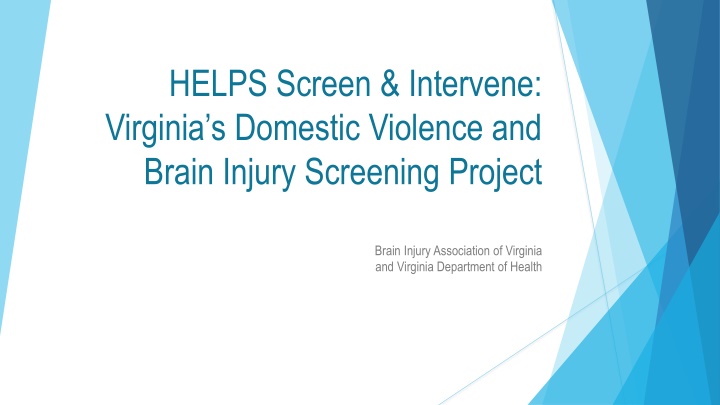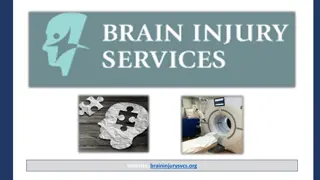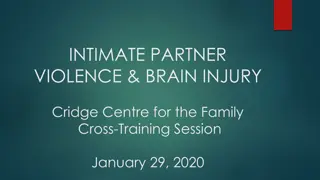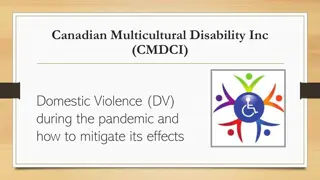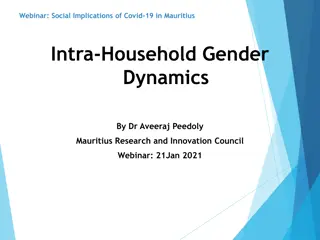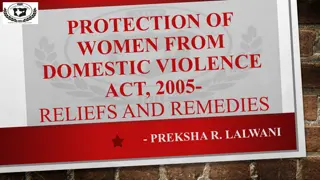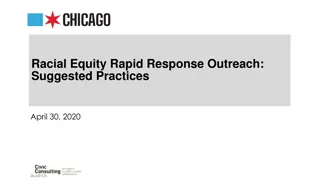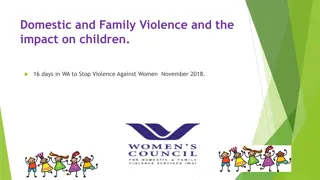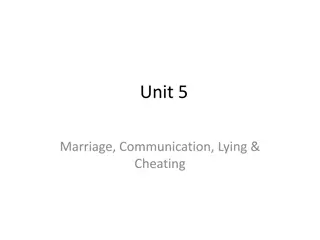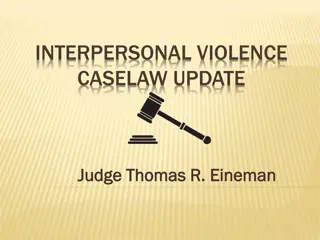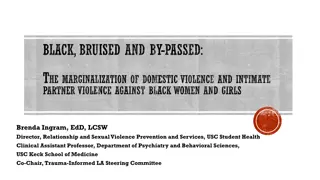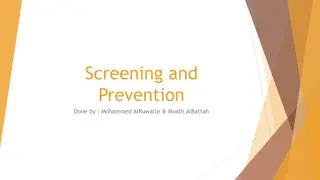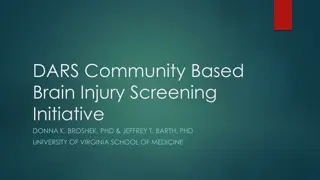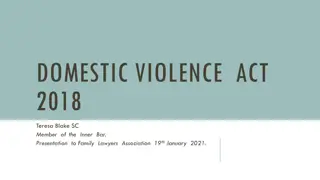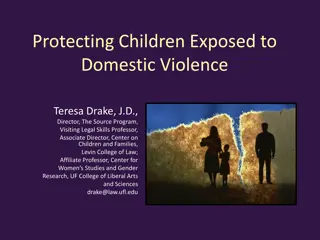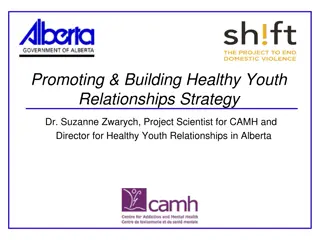Virginia's Domestic Violence and Brain Injury Screening Project
This project aims to investigate the intersection between DV/IPV and Brain Injury in Virginia through a partnership between the Brain Injury Association of Virginia and the Virginia Department of Health. It seeks to implement a statewide screening program for brain injury and raise awareness about the prevalence and impact of intimate partner violence on brain injuries.
Download Presentation

Please find below an Image/Link to download the presentation.
The content on the website is provided AS IS for your information and personal use only. It may not be sold, licensed, or shared on other websites without obtaining consent from the author.If you encounter any issues during the download, it is possible that the publisher has removed the file from their server.
You are allowed to download the files provided on this website for personal or commercial use, subject to the condition that they are used lawfully. All files are the property of their respective owners.
The content on the website is provided AS IS for your information and personal use only. It may not be sold, licensed, or shared on other websites without obtaining consent from the author.
E N D
Presentation Transcript
HELPS Screen & Intervene: Virginia s Domestic Violence and Brain Injury Screening Project Brain Injury Association of Virginia and Virginia Department of Health
Acronyms you may encounter within this presentation: IVP Intimate Partner Violence DV Domestic Violence TBI Traumatic Brain Injury
What is the Screen & Intervene Project? A partnership between the Brain Injury Association of Virginia and the Virginia Department of Health to investigate the intersection between DV/IPV and Brain Injury Both agencies had been doing separate work on head injury and IPV and were looking to expand The goal is to implement a statewide screening program for brain injury
Understanding Intimate Partner Violence A pattern of assaultive and coercive behaviors that may include: inflicted physical injury, psychological abuse, sexual assault, progressive social isolation, stalking, deprivation, intimidation, and threats. These behaviors are perpetrated by someone who is, was, or wishes to be involved in an intimate or dating relationship and aims at establishing control by one partner over another. MYTH of mutual abuse
What Does Intimate Partner Violence Look Like? 1 in 4 women; 1 in 7 men will experience IPV in their lifetime 1 in 3 women killed in the U.S. are at the hands of an intimate partner Previous strangulation increases likeliness for homicide by 750% Presence of a gun in a IPV situation increases risk of homicide for women by 500% 20 people per minute are victims of physical violence by intimate partner in the U.S. Leading cause of death among pregnant women is homicide by intimate partner In Virginia, black women are 3-4x more likely to be killed by an intimate partner 47% of women killed by their intimate partners have been seen by a health care provider in the year prior to their deaths
What is the relationship between DV & BI? Intimate partner violence (IPV) results in ~2 million injuries every year. Of those, only 1%, or less than 10,000 victims, are appropriately identified by the health care system As many as 23,000,000 women in the US who have experienced IPV also live with brain injury The rates of TBI in women who are seen in the emergency room or in a domestic violence shelter are between 30-74%; most occur from a direct blow to the head or from strangulation. 81% of 115 patients reported loss of consciousness at the time of a domestic assault; only 21% sought medical help
Of the 65 clients with complete data, these are their sociodemographic characteristics. Non- binary 6% 46% with less than $20,000 for income 52% Male 11% 25% 15% 8% Female (including trans female) 83% <25 26 - 45 46 - 65 65+ 58% White, non-Hispanic/Latino(a/x) 37% Black, non-Hispanic/Latino(a/x) 23% are unemployed, not able to work, or retired Hispanic/Latino(a/x), all races 11% Other or unknown race(s) 8%
Three-quarters (75%) of clients reported being hit in the head, choked, or strangled. Of these 49 clients, 51% of the head injuries were due to an assault or a fight. By assault or fight By fall Playing sports Car crash Other
Of the clients that were hit in the head, choked, or strangled, almost one out of four clients were hit, choked, or strangled more than 6 times. 24% 1 - 3 times 4 -6 times More than 6 times Not sure
Forty-five percent of clients who were hit in the head, choked, or strangled had their injury happen within the past 12 months. Past month or past year 1 - 5 years ago More than 5 years ago
Of the clients who were hit in the head, choked, or strangled: 71% reported having a period of feeling dazed and confused after their injury 61% reported having a period of blacking out after their injury 53% went to the emergency room, the hospital, or saw a doctor for their injury
Over6 out of 10 clients who were hit in the head, choked, or strangled reported problems in their daily life as a result of their injury. Clients most frequently reported these current and past symptoms: Physical Cognitive Emotional Feeling irritable or impatient 71% Problems focusing or concentrating 71% Headaches 76% Problems remembering 61% Dizziness 65% Feeling confused 71%
Seventy-six percent of clients who were hit in the head, choked, or strangled screened positive for a potential brain injury.
Of the 37 clients who screened positive for a potential brain injury, 30% were referred to their local brain injury program. Nineteen percentwere referred to a medical professional. Referral/plan to refer to local brain injury program Referral to state brain injury program Education on brain injury screening Education on brain injury Referral to medical professional No steps taken Other steps taken Steps taken after positive screen were not mutually exclusive, and more than one step could have been taken on behalf of the client.
Other Findings So Far 40 agency staff members trained about brain injury and how to screen for it Between 10-15 clients were taken into case management at a local BI program
Future Directions Expanding the current project by bringing in new partners and new regions for a coordinated statewide Screening for domestic violence effort within the brain injury community Training about IPV with BI providers
